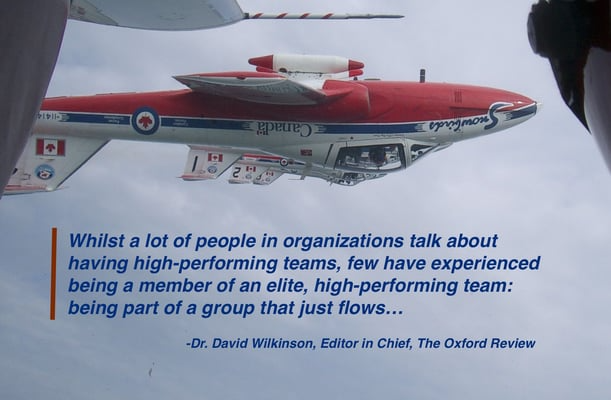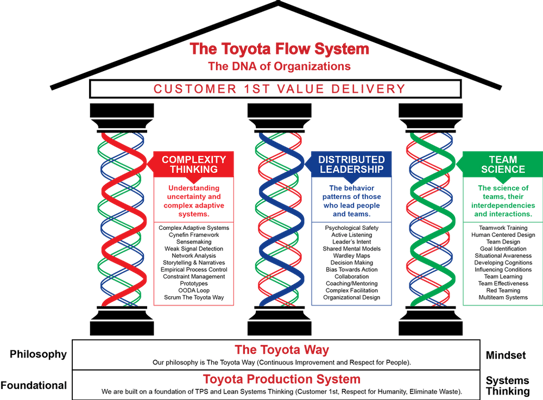
Many industry leaders found themselves in complex environments that had silently overwhelmed their traditional ways of operating. 20th century business practices that relied on process optimization and workforce efficiency were no longer effective. Much like my experience in Iraq, today’s complex world held a mirror to industry leaders.
Why Build Teams?
During her 2016 testimony to the Senate Armed Service committee on the utility of cross-functional teams, Amy C. Edmondson, Novartis Professor of Leadership and Management at Harvard Business School, identified that work in today’s companies is increasingly carried out by teams. She also pointed out that “Teams function as a key mechanism for organizational learning.” And it is collective learning that, according to Edmondson, ultimately determines organizational survival [2]. In essence, teams are an organization’s best change agent.
In a 2019 Oxford Review Special Report on High-Performance Teams, researchers suggest that teams are ideal for jobs [3]:
- That are complex
- Where creativity is needed
- Where the task is cross-functional
- When resilience is needed
- When learning is required

The Future Jobs Report by the World Economic Forum shows the growing need for “human” or “non-technical” skills as we move toward 2022. These “human” skills are what we consider teamwork or teaming skills.
Similarly, in IBM’s The Enterprise Guide to Closing the Skills Gap report, non-technical or behavioral skills such as teamwork, communication, empathy, and adaptability are identified as the most critical skills needed by workers in the age of automation, machine learning, and artificial intelligence.

Even the military is getting behind leadership and teamwork development. In Understanding and Decision Making, a 2016 military Joint Doctrine published by the British Ministry of Defence, the authors point out that “common team processes are vital to helping disparate organizations work together effectively”



As you look at the Table 2.2 from the JDP 4.0, you may notice some connections to the Distributed Leadership and Team Science helixes of the The Flow System™. JDP 4.0 also dives into Red Teaming, Situational Awareness, and complex adaptive systems, elements found in the The Flow System™.
So what does this all mean?
The need to develop leadership and teamwork skills is industry agnostic yet few training organizations have the expertise to connect teamwork training to today’s Agile and Lean methods. Moreover, organizational leaders who are commonly promoted not on their leadership skills but on their technical skills, make the mistake of granting an implied teamwork waiver to themselves, their peers, and subordinates through the adaption of Agile and Lean approaches.
There is No Waiver for Teamwork… and Leadership
The illusion of agility through the application of popular Agile frameworks and Lean approaches miss the mark simply because they provide an implied teamwork waiver and, by extension, a leadership waiver. Consider Scrum, the popular five-stage team framework based on the OODA loop of fighter aviation and the Toyota Production System. This framework (it is actually a method) describes the way teams work, not how they work. Scrum is perfect for interdependent work (cross-functional teams) but falls short in explaining how teams actually work–the transportable non-technical skills that must be learned, practiced, and reinforced at every level of an organization. This is where Team Science comes in and one reason it is an interdependent component of The Flow System™.
Some Background on Team Science
Teaming (Verb)
According to Harvard Professor Amy C. Edmondson, teaming is the process of teamwork. Teaming is a verb and the engine of organizational learning; it provides the transportable human or soft skills needed to develop high-performing static or ad hoc teams. The purpose of teaming is to improve the flow of information and expand expertise so organizations can learn and deliver value to their customers.
What the Research Says About How to Develop Real Teams
Team science researchers suggest that educational lectures where team “members passively learn about teamwork is not an effective way of improving teamwork.” Instead, teamwork training “should incorporate experiential activities that provide participants with more active ways of leaning and practicing teamwork [4].”




Does Team Building Work?
Unfortunately, studies of team building have shown that it is not as effective as teamwork development intervention (TDI) training. But do not fret, a trip to Top Golf or a ropes course are valuable social activities but they do not target teaming skills. And be careful when using “trust” drills.
Teamwork Development Intervention. What the Science Says.
Teamwork Development Interventions are systematic activities aimed at improving requisite team competencies, processes, and overall effectiveness [4]. Blah Blah Blah. Translation: Use interdependent experiential activities where small teams can practice and review how they work.
Team Development Interventions include:
- Teaming Training. Evidence-based strategies designed to increase the members’ knowledge, skills, and attitudes underlying effective communication, planning, sense-making, decision-making, leadership, adaptability and situational awareness.
- Team Debriefs. Are one of the most prominent methods for accelerating learning from “experience” and targets team processes. According to researchers in Team Science, debriefs should be structured with 60% effort focused on teaming skills and 40% on technical skills. Moreover, leading an effective debrief, also known as retrospectives and AARs, is not something that comes natural to leaders. In fact, research show that “simply having good interpersonal skills and technical competence does not ensure that a person will lead an effective debrief [5].”
The Power of Simulation
Teamwork Development Intervention through simulation has been found to be an efficacious approach to building real teams. Researchers also point out that aviation and the military are among the pioneers in using simulation as a prerequisite to building effective teams. A little secret: Most of us on the TFS team happen to have military aviation backgrounds and we use a simulation designed for building teaming skills… in every industry. In fact, our current computer-based simulators, GemaSim, were designed to improve teaming skills for remotely piloted aircraft crews and have exapted into healthcare, oil and gas, diving, and now digital transformations.



Anthro-Simulation
One of the more advanced approaches we use during our High-Performance Teaming and Leadership workshops is a concept developed by Gary Klein and Dave Snowden. The idea is simple: we learn more from failure than we do from success. Anthro-simulation is simply human and machine manipulation of the environment where we try to drive teams to failure. We also use proven approaches to capture individual and team situational awareness through techniques developed by Gary Klein and Dave Snowden.
Imagine the power of Team Science applied to Agile and Lean practices…
We have. And we know how.

1. General Stanley McChrystal, 2016 Testimony given to the Senate Armed Service Committee on the need for cross-functional Teams. https://www.armed-services.senate.gov/imo/media/doc/McChrystal_06-28-16.pdf
2. Amy. C Edmondson, 2016 2016 Testimony given to the Senate Armed Service Committee on the need for cross-functional Teams. https://www.armed-services.senate.gov/hearings/16-06-28-improving-strategic-integration-at-the-department-of-defense
3. D. J. Wilkinson, “High-Performance Teams: What the research says,” The Oxford Review, February 2019. https://www.oxford-review.com/blog-high-performance-teams-report/
4. C. Lacerenza, S. Tannenbaum, S. Marlow and E. Salas, “Team Development Interventions: Evidence-Based Approaches for Improving Teamwork,” The Science of Teamwork, American Pyschologist, vol. 73, no. 4, pp. 517-531, May-June 2018.
5. Dismukes, R.K., Jobe, K.K, & McDonnell, L.K. (2000). Facilitating LOFT debriefings: A critical analysis. In R. K. Dismukes & G. M. Smith (Eds.), Facilitation in aviation training and operations (pp. 13-25). Aldershot, UK: Ashgate
5. G. Goodwin, N. Blacksmith and C. M., “The Science of Teams in the Military: Contributions From Over 60 Years of Research,” The Science of Teamwork, pp. 322-333, May-June 2018.
6. Reyes, D.L., Tannenbaum, S.I., Salas, E. Team Development: The Power of Debriefing. People + Strategy HR Journal, Vol. 41, Iss. 2. Spring 2018 (46-51)

